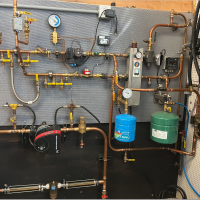Water Source Heat Pump Piping
Hello, I am working on a project which has Water Source Heat Pump (WSHP) as their main system. The building has boiler for heat injection into the WSHP system and for domestic purposes. The building also has cooling tower for heat rejection for the WSHP system. I came across this piping arrangement shown in the picture below highlighted in the dotted box. It shows water going in (called heat injection incorrectly) upstream of the water going out.
Is this piping arrangement correct? I always thought that the water should come out before going in to maintain the hydraulic continuity and also it doesn't make sense to inject heating before going out.
Please let me know if this correct? Thank you.
Comments
-
These systems were very popular back in the 80s and 90s and worked pretty well. I don't have a drawing available and haven't worked on these systems in a while so I will just make some comments.
Most of these systems used a closed-circuit cooler instead of a water tower and the whole system is glycol protected. The reason for this is the system needs to run in the winter when a water tower is problematic and can ice up. Closed circuit coolers usually run as a "dry cooler" in the winter by running the fan and draining the sump of water.
The system needs to be piped so that some WSHPs may be heating and some may be cooling at the same time. You want the water in the system to mix for all the HPs so you don't run the boiler or tower more than needed.
The 3-way valve is to allow the boiler to run at a temp higher than 130 without overheating the WSHP loop This was in the day when condensing boilers were not available. The HP loop is usually maintained at 80-90 deg. You want the boiler at higher temp for DHW production then mix down the boiler supply to the HP loop.
I am sure there are drawings available. have to search around
0 -
it doesn’t matter that much.
you like counter flow for thermal shock.0 -
Hi,
Just to clarify, I am talking about the piping arrangement in the dotted box. I have pasted another piping arrangement which I think should be the right way (in the dotted box). Can anyone let me know which one is the more efficient and correct arrangement?
Thank you.
0 -
It looks like you want a 3 way motorized diverting valve
The valve body will have arrows indicating flow direction. A diverter has one inlet, two outlet.
Bob "hot rod" Rohr
trainer for Caleffi NA
Living the hydronic dream0 -
IMHO neither drawing is correct
I will say it again. if you making DHW with the boiler it will have to be a minimum of 140 deg to make domestic HW probably higher.
You can't put 140 into the heat pump loop with a diverting valve. Every heat pump will trip out on the refrigeration pressure controls if you try that.
You need to come out of the boiler supply and go to the DHW HX. A tee in that line will feed the heat pump loop through the diverting valve (if you keep that). Before it gets to the diverting valve the boiler supply needs to be mixed down to 90 degrees etc with a 3 way mixing valve.
SEE THE ATTACHED
You don't need the Diverting valve . You need a 3 way mixing valve to control the boiler water temp so you don't send 140 (or higher) into the HP loop.
You don't separate the boiler from the tower wit the diverting valve. The same water flows though the boiler and water tower (or hx) and the heat pumps. The controls sense the loop temp and then tell the boiler to add heat or tell the tower to reject heat.
The Trane drawing has no mixing valve because they are not making DHW off the boiler and there is no diverting valve
0
Categories
- All Categories
- 87.3K THE MAIN WALL
- 3.2K A-C, Heat Pumps & Refrigeration
- 61 Biomass
- 427 Carbon Monoxide Awareness
- 119 Chimneys & Flues
- 2.1K Domestic Hot Water
- 5.8K Gas Heating
- 115 Geothermal
- 165 Indoor-Air Quality
- 3.7K Oil Heating
- 76 Pipe Deterioration
- 1K Plumbing
- 6.5K Radiant Heating
- 395 Solar
- 15.6K Strictly Steam
- 3.4K Thermostats and Controls
- 56 Water Quality
- 51 Industry Classes
- 50 Job Opportunities
- 18 Recall Announcements

